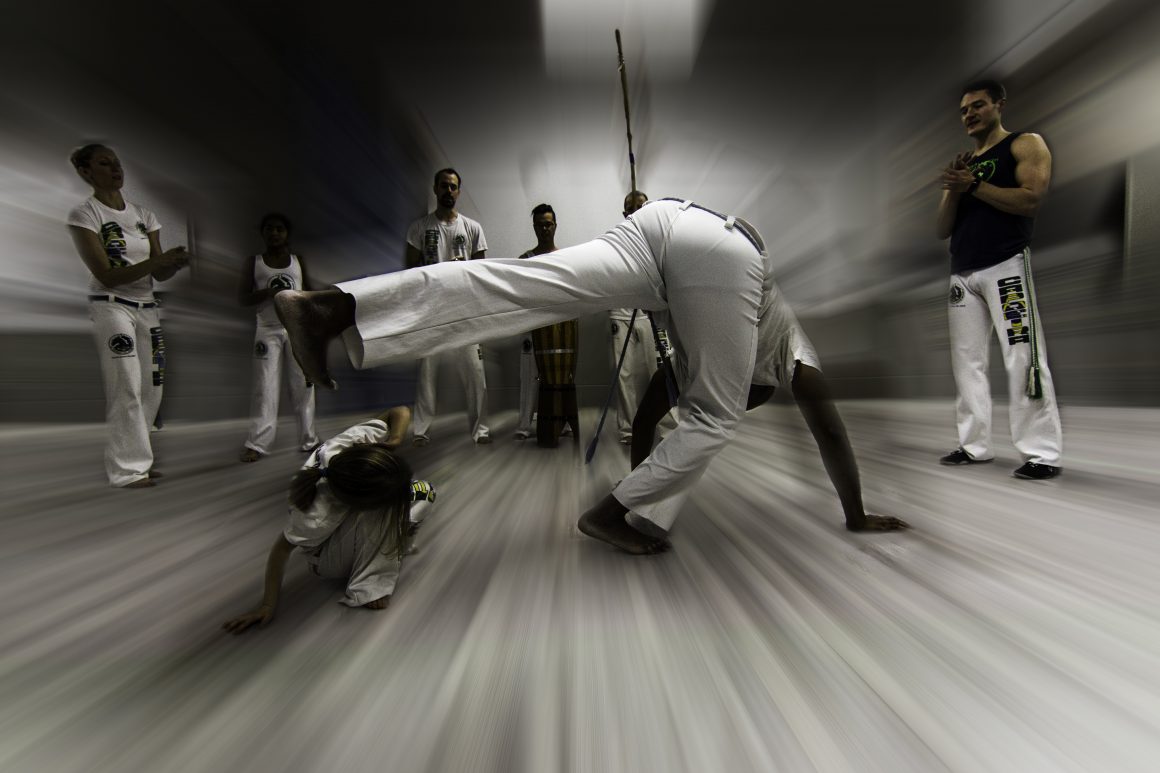
Brazilian martial arts offers dynamic and fulfilling workout
By Christie Melhorn, December 8 2017 —
While studying abroad in Trinidad and Tobago with the University of Calgary, I took a workshop in Calinda — competitive stick fighting that hybridizes martial arts and Afro-Caribbean folk dancing. It emerged during the 18th century as a form of resistance against colonial forces and was integral during the emancipation of Afro-Caribbean slaves. I remember being surprised by my own force as I chanted and lunged barefoot throughout the room. It was visceral and empowering.
Just last week, I learned U of C’s Active Living centre currently teaches a similar practice — Capoeira, Brazil’s national sport, which blends martial arts, acrobatics, music and dance. In Capoeira: The History of an Afro-Brazilian Martial Art, Matthias Röhrig Assunção says it’s an amalgamation of cultural traditions. Similar to Calinda, Capoeira was a method of self-preservation and artistic expression among Afro-Latin slave communities.
Slaves planning to escape oppression disguised martial arts training as traditional African dances to prevent suspicion, merging the two into a rhythmic entity. Communities of escaped slaves, called quilombos, continued Capoeira to fight colonial threats and strengthen social bonds. The practice is continuously evolving but embraces human resiliency and connection at its core.
This past week, I tried the art for the first time at Capoeira Aché Brasil Calgary (ABC) just off 37th Ave. on Edmonton Trail. My nerves were quickly eased by my instructor, Vlad Gincher, and his wife and five-year-old daughter when they warmly welcomed me to “the family.”
Gincher is also U of C’s Capoeira instructor. He says the community welcomes everyone and values reciprocity.
“It’s multicultural and for all genders and ages. It’s about helping each other and having fun. Everyone involved is happy to share their energy,” Gincher said. “The friendships and support is where the true value of the practice is.”
This reflected in the people I met at Capoeira ABC. A children’s class took place at the same time as the adult session next door. One of Gincher’s advanced students led a quick warm-up of cardio and stretching. Afterwards, we practised basic kicks and escapes individually and with partners. While my African dance background gave me an advantage, it was a refreshing challenge. Cartwheeling across the floor worked neglected muscles and I had to increase my spatial awareness to maintain fluidity.
The room’s atmosphere was warm and encouraging. My fellow students were patient and thorough, slowing down when necessary and commending my efforts. Despite its physical demands, elements of the class were light and playful. Memories of freely tumbling around my backyard as a kid came to mind.
Gincher says that Capoeira is a whole-body workout and artistic expression that enhances cognitive function.
“In Capoeira, you learn so many different skills. It gives you a new respect and awareness for your body and what you’re capable of,” Gincher said. “You’re clapping, singing, playing an instrument, learning new movement and rhythms but also attacking and blocking. It triggers your brain to think in different patterns.”
After an hour, the kids’ class joined ours for roda — a circle in which Capoeira is performed with music. Students took turns playing a drum, a tambourine and the berimbau — a single-string percussion instrument with a heavy twang. Students entered the circle in pairs by crouching in front of the musicians, holding hands then cartwheeling into the centre. Those outside the circle clapped and sang words of encouragement in Portuguese.
As someone with high anxiety, I sometimes struggle to slow my thoughts and be in the present. However, the incredible athleticism, rhythm and spirit cycling through the room captivated me. Despite being a novice, I genuinely wanted to participate and was particularly touched by the confidence of the children. They proudly swung kicks and even performed headstands with adult Capoeiristas.
Gincher says the friendships and spiritual element in Capoeira distinguishes it from other sports. He says it holds many mental and physical health benefits for students.
“I played a bunch of different sports but the community and culture of Capoeira gave new meaning to my life. You feel the energy of others and let go,” Gincher said. “It gave me confidence in myself and in school. When you exercise, you get fulfillment from pushing yourself and have more energy. If you feel healthier, you study better.”
Gincher says that he strives to help actualize his students potential.
“As a Capoeira teacher, your goal isn’t to be the very best but to nurture the quality of your students,” Gincher said. “I want to give my students everything I can to bring out their best and keep spreading Capoeira.”
When class finished, all of us patted each other on the back while clasping hands. While I was out of my comfort zone, the kindness I experienced left me wanting to learn more.
U of C’s Active Living center offers Capoeira every Tuesday from 8:30–10 p.m. The winter session commences on Jan. 16. The 12-week program is $105 and Capoeira ABC offers a free trial class for first-timers.
To learn more about Capoeira ABC click here and here for more information about Active Living’s Capoeira program.
